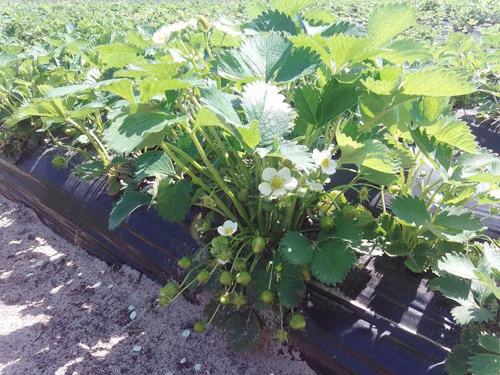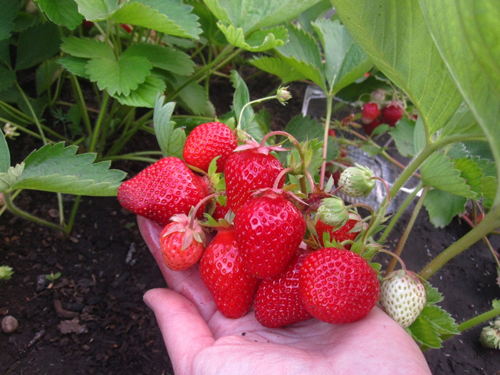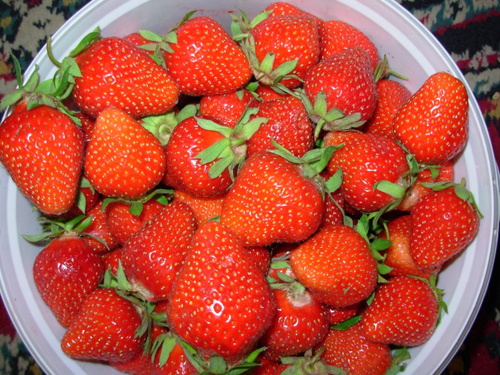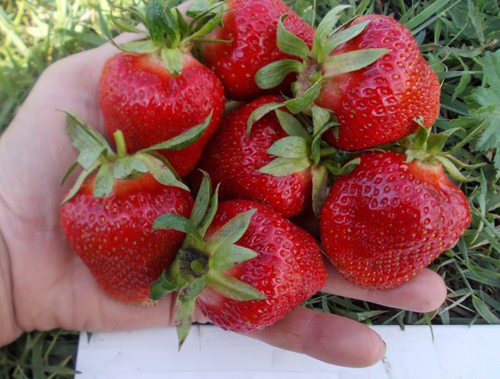Clery strawberry variety
Clery is a variety of garden strawberries (strawberries) of early ripening. One of the ten best commercial varieties. It is appreciated for the excellent taste of berries and their excellent presentation, high yield, unpretentious care. Our hero was bred in 1996 in Italy, in the city of Comacchio, the "parents" were the varieties Sweet Charlie and Onebor. Since 1998, the "novelty" has been registered and patented. Recommended for indoor cultivation, but also shows very good results outdoors. Suitable for cultivation in Central Russia and southern regions, as well as in Belarus and Ukraine. It is most widespread in European countries.

The plant is tall, vigorous, semi-spreading, medium-leafy. Clery bushes are slightly spherical, they look quite compact. The leaves are large, bright dark green, shiny, sometimes light. The formation is very abundant. The flowers are bisexual, no additional pollination is required for strawberries. Peduncles are thick, strong, with good pubescence, located at the level of the leaves. The plant forms quite a lot of peduncles, due to which the bushes are literally strewn with fruits.
Clery berries have a regular, elongated-conical shape, and what is noteworthy, the fruits are very uniform in shape, as for selection, comb-shaped specimens or "freaks" you will not find on your plantation. The skin is strong, bright carmine-red saturated color with a characteristic shine. The pulp is bright red, very juicy, firm, moderately aromatic. The core of the fruit is slightly whitish in the center.

The taste of the variety is excellent. The berries are very sweet, sometimes even sugary, with an unobtrusive, barely noticeable sourness, which only emphasizes the sugar content. However, gardeners very often argue about the taste of strawberries - some praise it very much, others do not see something special in it. Often, with mistakes in agricultural technology and unfavorable season conditions, the fruits can be excessively sour, but we will talk about this a little later.
Clery berries are suitable for transportation, in their original form they perfectly reach the market and attract buyers with their homogeneity. During harvest, they are easily separated from the stalk and remain dry and beautiful. In use, the fruits are universal, excellent fresh and canned, well suited for freezing. It should be said that this variety fully justifies its name "commercial", since its berries look really very attractive and focus on themselves on the market.

The average weight of berries in the season is 23-30 grams, the largest have a weight of 40-45 grams. Strawberries are characterized by fairly stable fruiting; by the end of the season, the fruits are not very shallow. Also, Clery's advantage is amicable ripening, which is very convenient - the collection takes place in a short time. The variety is high-yielding, it is possible to harvest 290 centners of berries from a hectare of area. From one plant, an average of 1-1.5 kg of fruits is obtained, sometimes up to 2 kg, in a closed ground the indicator can increase. Many sources report that such a yield cannot be called high, however, in our opinion, this is a very controversial statement. So, for example, at a remontant Queen Elizabeth 2 the maximum yield indicator is 350 c / ha, for a medium-early non-repaired Honey - 150 c / ha, at medium late Gigantella Maxim - 143 c / ha. Thus, it really does not work out to say that our hero loses to other popular varieties! In addition, Clery is not a remontant strawberry, so she can only be proud of her yield indicators.

The plant belongs to varieties of short daylight hours, in terms of ripening, the variety is early maturing. Flowering begins in early May, in the southern regions a little earlier, indoors and in general can start in mid-April. By the way, according to gardeners' reviews, flowers are practically not damaged by spring frosts.Fruiting begins around mid-May, a few days earlier Elsants and a week or two earlier Honey. Clery quickly gives up the entire crop, for about 3-4 harvests. Ripening occurs amicably, there is a high percentage of marketable berries, there are practically no substandard ones. This strawberry has one more feature - the fruits ripen gradually, filling with color from bottom to tip. Insufficiently ripe berries can have an almost complete red color, but when bitten they will crunch like an apple.

Plants have very good resistance to diseases of the root system, various fungal diseases, but moderate resistance to white and brown spots. As for winter hardiness, it should be said that Clery is a thermophilic strawberry and was originally bred for mild climates with very warm winters. Thus, plants need good shelter in winter, especially in the northern regions. The variety has good drought resistance, however, a long lack of moisture will have a very bad effect on the health of plants and the taste of berries. But it is also not worth overmoistening the soil - with excessive moisture, the taste of the fruit also deteriorates, it becomes unnecessarily sour. By the way, in very rainy seasons this becomes a serious problem - the harvest will not delight you with its taste, but you should not jump to conclusions and get rid of the variety. On the other hand, some gardeners claim that the berries remain sweet even during rainy periods. In a word, it can be assumed that this nuance rather depends on the literacy of agricultural cultivation techniques.
Clery is relatively undemanding to soil, but it is extremely important to provide strawberries with sufficient nutrition from the first days of her life on the site. Before planting, it is imperative to apply organic fertilizers to the soil, and in some cases (for example, on sandy loam) and mineral complexes. By the way, do not expect a good harvest in the first year after planting - the plants can show full-fledged productivity only in the second year of living on the site.
Bushes should be planted at a distance of 35-40 cm from each other. The place for planting should be sunny, since the variety is very fond of warmth and light, and with a sufficient amount of sunlight, it forms sweeter berries. Despite its drought tolerance, the plant tolerates heat very painfully, so it is advisable to take care of the shading of the plantation and timely watering in order to at least slightly reduce the damage. When it comes to top dressing, strawberries respond very well to them, but do not require an increased amount of fertilizer, like some other high-yielding varieties. It will be enough to carry out 2-3 feeding per season, foliar feeding also makes sense, especially if the use of plants is quite intensive.
Clery is suitable for growing both outdoors and indoors, while in the second case, the yield increases significantly. However, with intensive cultivation under shelters, in greenhouses and greenhouses, the plants weaken faster, so it is advisable to rejuvenate the plantation after two years of use, or even after a year. In the open field, strawberries reach their peak fruiting in the second year of cultivation, in the third year they "slow down" a little, and then the yield indicators sharply decrease, so rejuvenation should be carried out every three years. Care must also be taken to remove excess mustache. As already mentioned, the variety forms quite a lot of them, and if you do not monitor their number, you can not hope for a good harvest. On the other hand, abundant formation can be considered a plus - there will be more than enough seedlings for sale, and it will not be difficult to multiply your plantation, especially since the plants root perfectly.
In conclusion, we can say the following. Clery is a wonderful strawberry that has won the trust of many gardeners and large agricultural firms in various countries. It is high-yielding, has excellent taste, is famous for its beautiful homogeneous berries, and is also quite unpretentious in care and does not require abundant "feeding".But, along with this large list of advantages, it also has some disadvantages. First, many people complain about the sour taste of the fruit. This is mainly due to lack of nutrients and heat. The first problem is quite simple to solve, the second is also not particularly scary - it is enough to use covering materials or practice growing in high beds. Another disadvantage is the dependence of the yield and health of strawberries on the climatic conditions of the season. For example, in the northern regions, Clery will show erratic results when grown outdoors. For the rest, the variety really deserves its place in the top ten and has more than once met the expectations of both ordinary gardeners and large agricultural complexes.









It has been growing in the country for several years and, in comparison with other varieties, is one of the most productive. Very tasty and pleasant aroma - like a real wild strawberry from the forest. True, the achenes are large. So if you start to drive juice from this berry, you will have to filter it later.
I was looking for a very early variety for open ground, and chose Clery. I was afraid that it would have a "plastic" taste, but the characteristics of this strawberry were confirmed - the berry is juicy, sweet, the pulp is dense. I love berries that are sweet enough so that you can eat right from the garden without sugar. Clery's strawberry is just that: sweet and without sourness. True, the strawberry garden is in the sun all day, I take good care of the strawberries - I fertilize them since early spring. First, I put ash under the bushes, later, before flowering, I water it with diluted chicken droppings, regularly watering it with plain water from a well. Berries are of the correct shape, which plays an important role in the design of desserts. Strawberries do not lose their appearance in compotes, jams and after storage in the freezer.